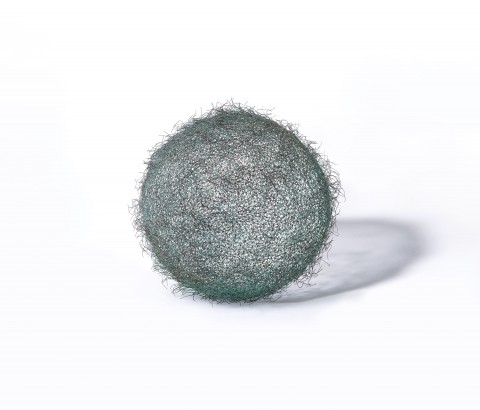CORONA, 1993
BRONWYN OLIVER
copper wire
32.0 cm diameter
Roslyn Oxley9 Gallery, Sydney
Private collection, Sydney
Fenner, F., Bronwyn Oliver Mnemonic Chords, Moet et Chandon, Epernay, France, 1995, pp. 5, 21 (illus.)
Murray-Cree, L., Awesome! Australian Art for Contemporary Kids, Craftsman House, Melbourne, c. 2002, pp. 86 – 87 (illus.)
Fink, H., Bronwyn Oliver: Strange Things, Piper Press, Sydney, 2017, p. 219
‘Each of Oliver's works emits a whisper of familiarity and flickering voice of humour and optimism. At a deeper level, they strike an emotional chord in viewers hardened by the cynicism of much contemporary art practice. The poetic resonance of her deftly imaginative and delightfully quirky creations provides rare moments of reprieve from today's didactic obsession with lobbying socio-political issues. There is no sarcastic commentary, modernist, psychoanalytical or feminist deconstruction informing Oliver's work. Each piece is offered as a holistic entity, its layers of association emerging gradually through the process of looking.’1
One of Australia's most innovative contemporary sculptors, Bronwyn Oliver remains celebrated for her extraordinary ability to produce meticulously articulated works of immense beauty and grace that unite timeless, organic forms of the natural world with the abstract logic of geometry. As elucidated by Hannah Fink in her introduction to the artist's exhibition at Roslyn Oxley9 Gallery in July 2006, '...Bronwyn was modest, yet utterly sure of her vision, secure in the confidence of her originality. Her art was fully resolved – perfect, really – and she stands alone in the annals of Australian art history. There was no-one like her: she invented her own deeply intelligent form and entered fully into the world that it opened out to her.'2
Simple yet complicated, fragile yet strong, eccentric though at the same time oddly straightforward, Corona, 1993 is a superb example of Oliver's delicately woven copper and bronze assemblages that universally surprise and inspire – beguiling both the eye and mind through their enigmatic presence. Bearing the patinated hallmarks of her early explorations, the sculpture emanates an ethereal, almost cosmic aura – alluding perhaps, as the title suggests, to a radiant sun with the delicate, elongated strands protruding from the circular body conjuring the outermost part of its atmosphere, only visible during an eclipse. Notwithstanding such connotations with the natural world however, ultimately the piece embodies its own eternal presence or life; as Oliver herself so fervently asserted of her objectives, ‘I am trying to create life. Not in the sense of beings, or animals, or plants, or machines, but "life" in the sense of a kind of force, a presence, an energy in my objects that human beings can respond to on the level of soul or spirit.'3
With their tactility and anatomical physicality, such intricately executed forms inevitably elicit a temptation to touch, reminding us that the world is a corporeal place. Yet too often the easy, sensuous curves of Oliver's objects belie the punishing, labour-intensive process to which the artist was so passionately committed. Inspired by the patina of age and veneration shared by ancient relics and humble artefacts, Oliver would painstakingly manipulate dizzying twistings and welds of pliant copper wire to create the 'weave' – the microstructure of her organic sculptural forms which gradually became more open and geometric to allow light to permeate and exaggerate their optical aspect. Indeed, the shadows cast by her objects are so intrinsic to the formalist geometry of each piece that at times the shadow itself almost becomes more powerful... becomes the object.
As Amanda Rowell mused in her introduction to Oliver's exhibition at Roslyn Oxley Gallery in September 2004, '...the microcosmic, complex surface of an Oliver sculpture is an interface between the macroform of its overall shape and the internal cavity or void where the sculpture breathes. The ease of connection between these three formal aspects of her works, along with their gently mimetic character - as alluded by their titles constitute their elegance and simple pleasure...'4
1. Fenner, F., Bronwyn Oliver: Mnemonic Chords, Moet et Chandon, Epernay, France, 1995, p. 4
2. Bronwyn Oliver (1959 - 2006), 10 July 2006, see http://www.roslynoxley9.com.au/news/ releases/2006/07/10/112/
3. Oliver cited in Sturgeon, G., Contemporary Australian Sculpture, Craftsman House, Sydney, 1991, p. 71
4. Bronwyn Oliver 2004, 9 September 2004, see http://www.roslynoxley9.com.au/news/releases/2004/09/08/80/
VERONICA ANGELATOS
